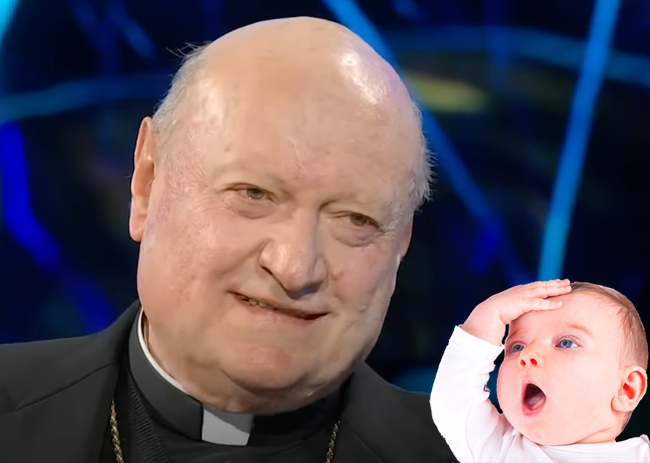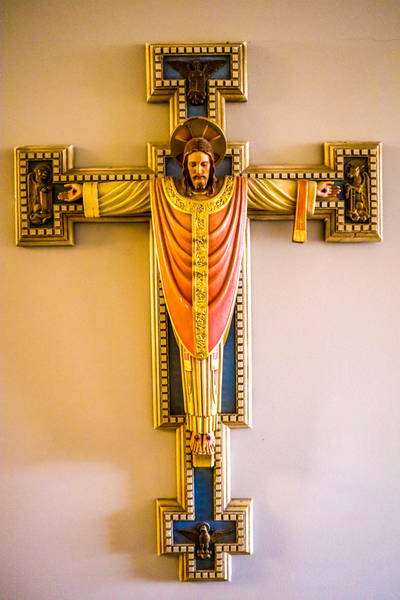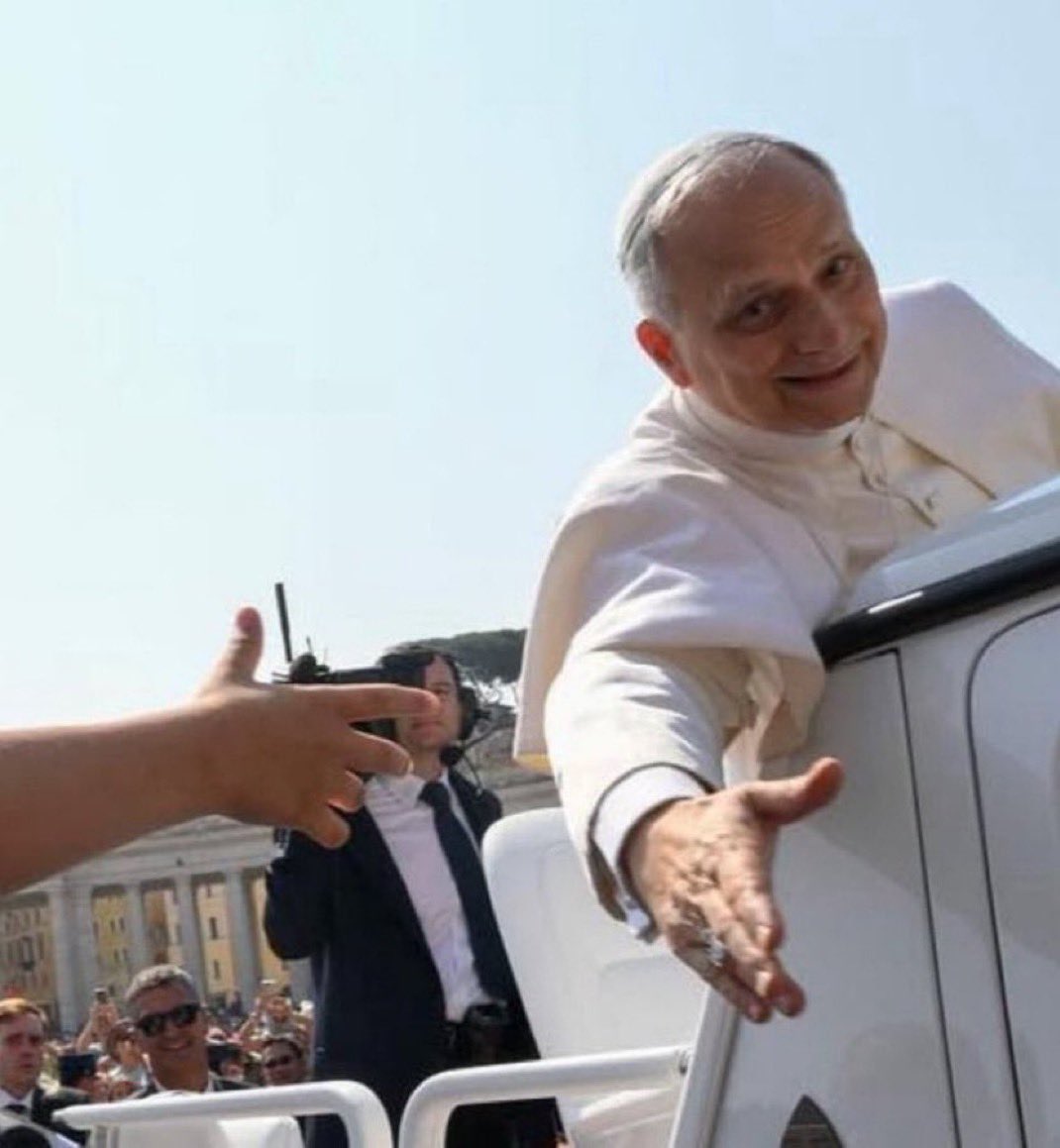“Called by God a high priest according to the order of Melchisedech” (Heb 5:10)…
Heresy from ‘Cardinal’ Ravasi: ‘Christ Was a Layman’

The Vatican’s recently-retired president of the so-called Pontifical Council for Culture (since 2022 the Dicastery for Culture and Education), ‘Cardinal’ Gianfranco Ravasi (b. 1942), has made news again, and not in a good way.
The 81-year-old Ravasi was ordained a priest in 1966 in the traditional rite of priestly ordination. In 2007, ‘Pope’ Benedict XVI personally conferred the invalid Novus Ordo rite of episcopal ordination on him, and three years later he made him a ‘cardinal’. Ravasi has been working in the Roman curia since at least 2007, when Benedict appointed him president of the Pontifical Council for Culture.
On Apr. 24, 2024, ‘His Eminence’ participated in a panel discussion at the Pontifical Lateran University in Rome as part of the ‘Courtyard of the Gentiles’ initiative his Culture department had launched in 2010. The topic was “Democracy, Power, and the Common Good”. Reports on the conference were written by Antonella Palermo and published in Osservatore Romano and Vatican News, respectively:
- Camminare tra democrazia e bene comune (Osservatore Romano)
- Potere, democrazia e bene comune. Ravasi: la malattia di oggi è l’apatia (Vatican News)
Speaking in the context of the proper relationship between Church and state and “the political teaching of Christ”, Ravasi dares to assert that Our Blessed Lord Jesus Christ was a layman:
The cardinal, president emeritus of what used to be the Pontifical Council for Culture, highlights the difficulty of the current challenge of walking between a theocratic model, with its statist parallel, of power management, and a model that takes into account the political teaching of Christ. On the one hand, the absolute verticalism that makes power derive from a superior entity or confines the sacred to a private temple without social implications; on the other hand, the assumption that it is human society that is the true subject, in which there are certain foundational values proposed by religion, since man and woman are the image of God (even the woman, the cardinal points out, “we often forget this”). The constant issue at stake, Ravasi warns, is the confusion of secular with secularist. And in this regard, he urges us not to forget that “Christ was a layman. Therefore, it is his presence that allows us to understand how he himself gave the impetus to overcome the theocratic model.”
(Antonella Palermo, “Potere, democrazia e bene comune. Ravasi: la malattia di oggi è l’apatia”, Vatican News, Apr. 24, 2024; underlining added. Translation via DeepL, revised.)
Christ Jesus was a layman?! Perhaps it is a testimony to the Naturalism and worldliness of the Vatican II religion that one of its cardinals could make such an incredibly foolish, blasphemous, and heretical assertion.
The Catholic Church teaches dogmatically:
The Divine Scripture says that Christ was made a high priest and apostle of our confession [Heb. 3:1] and in the odor of fragrance offered himself to God and the Father for us [Eph. 5:2]. Therefore, if anyone says that the Word of God Himself was not made our High-priest and Apostle, when He was made flesh [John 1:14] and man in our likeness, but that as it were another besides Himself specifically a man (born) of a woman, or if anyone says that He offered the oblation for Himself and not rather for us alone, for He who knew not sin would not have needed oblations, let him be anathema.
(Council of Ephesus, Canon 10; Denz. 122)
Obviously, the Catholic Church does not favor a theocracy, in which the state would be ruled by God through His representatives, the clergy. Rather, the ideal state as taught by the Church is the Catholic confessional state. In such a setup, Church and state each have their separate domains, but ultimately both are working towards the same end, and the state is always subject to the Church, albeit indirectly. Pope Leo XIII laid out all the principles on Church-state relations in his encyclical letter Immortale Dei (1885), but of course this was all overthrown by Roncalli‘s robber synod known as the Second Vatican Council (1962-65).
So, just where does Fr. Ravasi think his very own priesthood comes from if not from Jesus Christ, the Eternal High Priest? How does he think Our Lord made the Apostles priests and bishops at the Last Supper if He Himself was but a layman? “If anyone says that by these words: ‘Do this for a commemoration of me’ [Lk 22:19; 1 Cor 11:24], Christ did not make the apostles priests, or did not ordain that they and other priests might offer His own body and blood: let him be anathema” (Council of Trent; Denz. 949). The Catholic priest is an alter Christus (‘another Christ’) precisely because Christ is a priest!
It is true, of course, that Our Lord was not a member of the Mosaic priesthood, since He was from the tribe of Judah, not from the tribe of Levi. However, that fact does not make Christ a layman, for He does have a priesthood, but it is one of a different nature, one of infinitely greater excellence and dignity:
The Lord hath sworn, and he will not repent: Thou art a priest for ever according to the order of Melchisedech. (Psalm 109:4)
If then perfection was by the Levitical priesthood, (for under it the people received the law,) what further need was there that another priest should rise according to the order of Melchisedech, and not be called according to the order of Aaron? For the priesthood being translated, it is necessary that a translation also be made of the law. For he, of whom these things are spoken, is of another tribe, of which no one attended on the altar. For it is evident that our Lord sprung out of Juda: in which tribe Moses spoke nothing concerning priests. And it is yet far more evident: if according to the similitude of Melchisedech there ariseth another priest, who is made not according to the law of a carnal commandment, but according to the power of an indissoluble life: For he testifieth: Thou art a priest for ever, according to the order of Melchisedech. (Heb 7:11-17)
St. Paul’s Letter to the Hebrews is filled with references to, and explanations of, Christ’s eternal priesthood. Here are a few more quotes:
Wherefore it behoved him in all things to be made like unto his brethren, that he might become a merciful and faithful priest before God, that he might be a propitiation for the sins of the people. (Heb 2:17)
But this, for that he continueth for ever, hath an everlasting priesthood, whereby he is able also to save for ever them that come to God by him; always living to make intercession for us. For it was fitting that we should have such a high priest, holy, innocent, undefiled, separated from sinners, and made higher than the heavens; who needeth not daily (as the other priests) to offer sacrifices first for his own sins, and then for the people’s: for this he did once, in offering himself. (Heb 7:24-27)
But Christ, being come an high priest of the good things to come, by a greater and more perfect tabernacle not made with hand, that is, not of this creation: Neither by the blood of goats, or of calves, but by his own blood, entered once into the holies, having obtained eternal redemption. (Heb 9:11-12)
In his second-to-last encyclical letter, Pope Leo XIII highlighted the relationship between Christ’s own Priesthood and the ministerial priesthood He gave to His Church:
The Catholic priesthood — divine in its origin, supernatural in its essence, immutable in its character — is not an institution that can accommodate itself with ease to human systems and opinions. A participation of the eternal priesthood of Jesus Christ, it must perpetuate even to the consummation of ages the same mission that the Eternal Father confided to His Incarnate Word: “Sicut misit me Pater, et ego mitto vos” [“As the Father hath sent me, I also send you” (Jn 20:21)]. To work the eternal salvation of souls will always be the great commandment of which it must never fall short, as to faithfully fulfil it, it must never cease to have recourse to those supernatural aids and those divine rules of thought and of action which Jesus Christ gave His Apostles when He sent them throughout the whole world to convert the nations to the Gospel. Therefore St. Paul in his letters reminds us that the priest can never be anything but the legate, the minister of Christ, the dispenser of His mysteries [2 Cor 5:20; 6:4; 1 Cor 4:1], and he represents him to us as dwelling in a high place [Heb 5:1] as a mediator between heaven and earth, to treat with God, about the supreme interests of the human race, which are those of everlasting life. The idea that holy books give us of the Christian priesthood, is that it is a supernatural institution superior to all those of earth, and as far separated from them as the divine is from the human.
(Pope Leo XIII, Encyclical Fin Dal Principio, n. 3; underlining added.)
Of course, the eternal salvation of souls is not something the Vatican II Church is terribly interested in. That much is becoming more and more obvious every day.
In 1935, Pope Pius XI released an encyclical letter on the Catholic priesthood, in which he made known the institution of a special Votive Mass in honor of Jesus Christ the Eternal High Priest:
We wish to perpetuate the memory and the glory of that Priesthood, of which Ours and yours, Venerable Brethren, and that of all priests of Christ, is but a participation and continuation. We have thought it opportune, after consulting the Sacred Congregation of Rites, to prepare a special votive Mass, for Thursdays, according to liturgical rules: De summo et aeterno Iesu Christi Sacerdotio, to honor “Jesus Christ, Supreme and Eternal Priest.” It is Our pleasure and consolation to publish this Mass together with this, Our Encyclical Letter.
(Pope Pius XI, Encyclical Ad Catholici Sacerdotii, n. 91)
After almost six decades of celebrating the Novus Ordo Missae (‘New Mass’), which has made the Holy Sacrifice of the Mass into a liturgical happy meal, some Novus Ordo presbyters are apparently now beginning to think that Christ was but a layman. Then again, should this really be surprising, considering they are obviously not offering the Sacrifice of Calvary in their ‘Eucharistic celebrations’ anymore? In fact, some have even begun to deny that Christ offered a sin-atoning Sacrifice to the Father on the Cross on Mount Calvary:
Indeed, a religion whose highest expression seems to be found in the practice of the corporal works of mercy, whose liturgy is mainly about breaking bread with the assembled community, and for which faith consists not in assenting to divine revelation but in some experience of ‘encounter’… what use does such a religion have for an Eternal High Priest offering a Perfect Sacrifice to propitiate an offended God? For them, Christ might as well have been a layman — or a mere man, in fact, and not God at all.
 Once again betrayed by His own: Our Lord Jesus Christ, High Priest
Once again betrayed by His own: Our Lord Jesus Christ, High Priest
Before we conclude, a little more background on ‘Cardinal’ Ravasi may be helpful.
‘His Eminence’ made news in 2013 when, as head honcho of the Vatican’s culture department, he published a series of tweets paying tribute to American rock legend Lou Reed, who had just died. Reed’s most famous song was ‘Walk on the Wild Side’ (1972), a tune with lyrics that, according to Wikipedia, “touch[ed] on topics considered taboo at the time, such as transgender people, drugs, male prostitution, and [a disgusting sexual practice we won’t mention here].” Come to think of it, that certainly fits the ‘cultured’ Vatican these days!
In 2015, it was discovered that the year before, ‘Cardinal’ Ravasi had taken part in an idolatrous ceremony worshipping the pagan ‘Mother Earth’ goddess Gaia (aka Pachamama), apparently in connection with an event of his ‘Courtyard of the Gentiles’:
To be clear: That was years before the Vatican Amazon synod and the abominable rituals that went on there!
And last but not least, in 2021, Ravasi’s Council for Culture sponsored a three-day virtual ‘health’ conference which featured such highly edifying characters as New Age guru Deepak Chopra, rabid abortion advocate Chelsea Clinton, and supermodel Cindy Crawford. It even included an interview with Joe Perry, the founder and lead guitarist of Aerosmith, an American rock band that has made such lewd and immoral songs as “Walk on Water” (1995) and “Dude (Looks Like a Lady)”, a 1987 song about what is nowadays called a “transgender woman”.
The more obvious clergy like Ravasi make it that they are not Catholics, the better it will be for everyone.
Image source: Composite with elements from Shutterstock (Miti74) and YouTube (screenshot) / Shutterstock (BenDollarhide)
Licenses: paid and fair use / paid





No Comments
Be the first to start a conversation